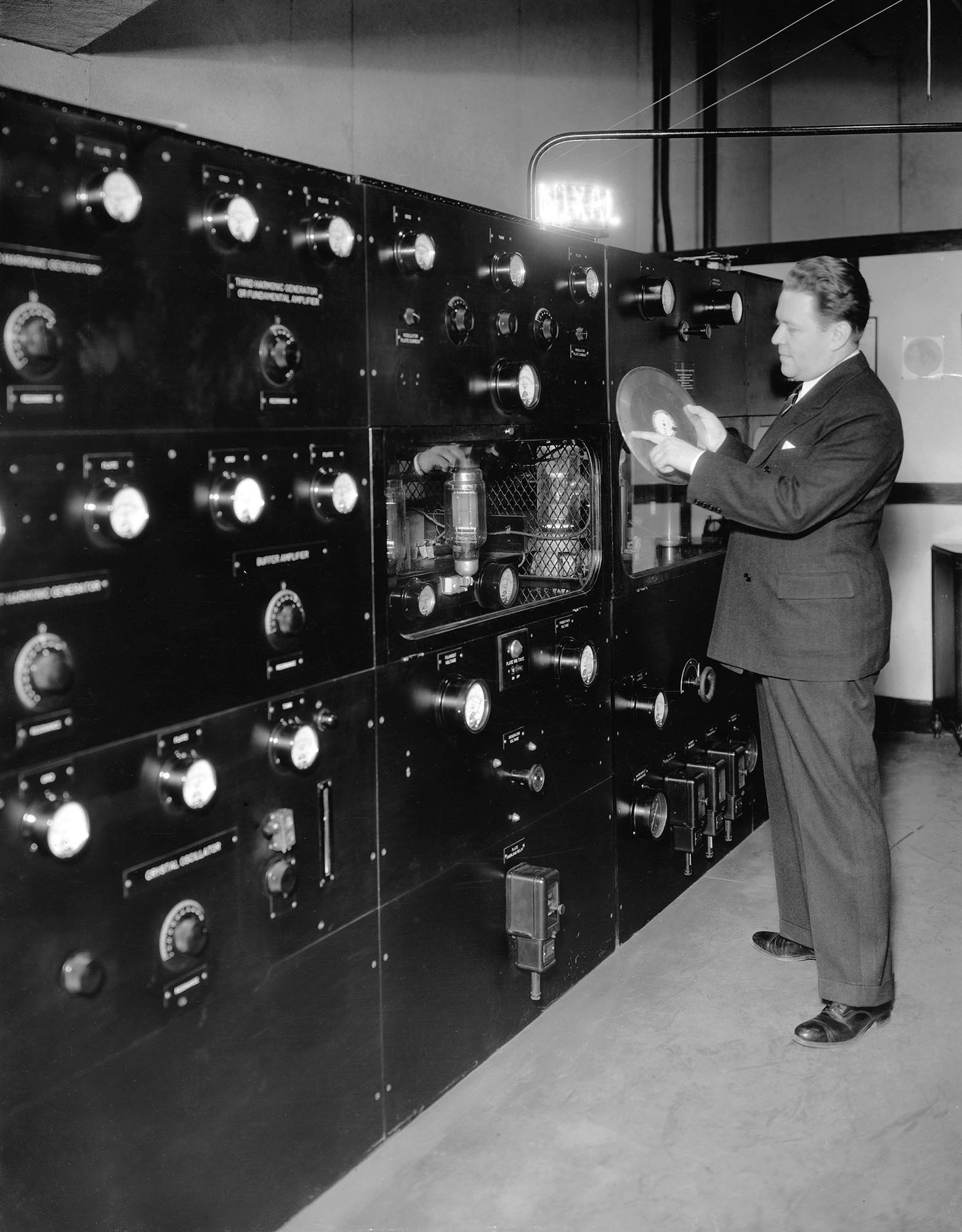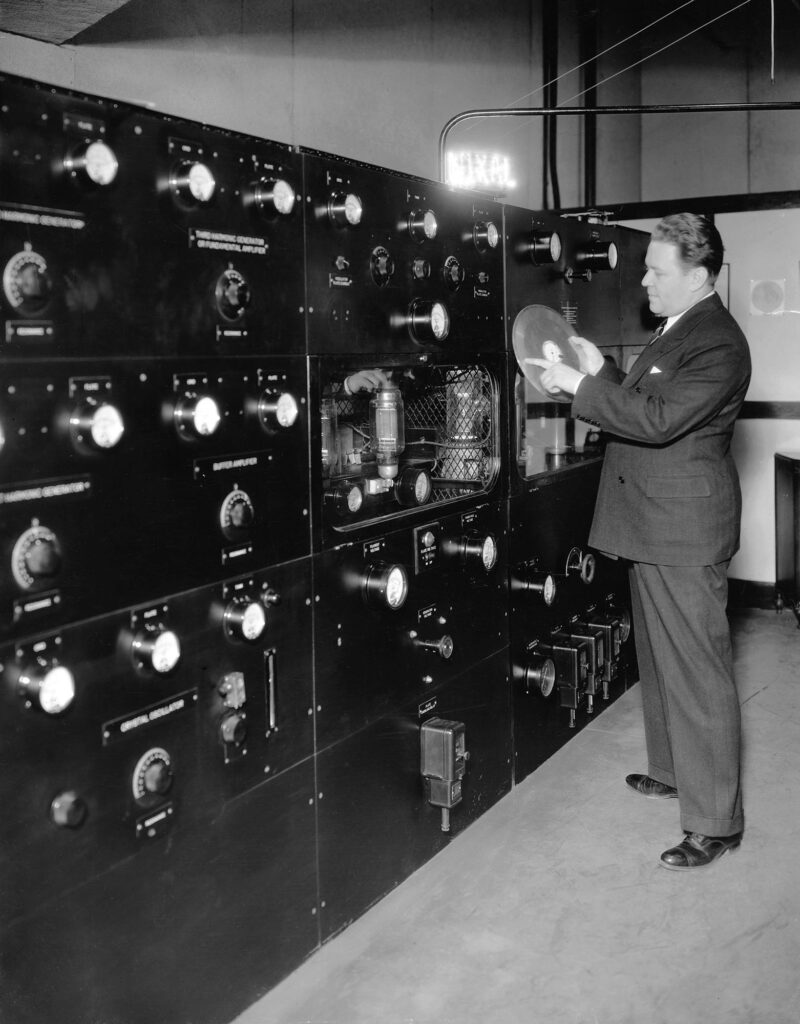As the Rockefeller Foundation (RF) broadened the scope of its humanities program in the 1930s, it considered the uses of new communications technologies. As any discerning listener in that decade understood, the possibilities of film and radio could be exploited for positive or negative ends. Their impact and their potential needed to be studied, and RF offered early support for the academic study of mass communications. The RF also funded educational uses of communication technologies, including important experimental work in documentary film and educational radio.
In a 1936 memorandum to his colleagues, David H. Stevens defined the goals of the humanities program in this emerging field:
Both radio and motion pictures are recognized as instrumentalities potentially of great importance alike for formal education and for the general diffusion of culture. But they have so far been exploited for the most part for purposes of entertainment.
David H. Stevens, 1936Inter-office Correspondence from David H. Stevens, January 22, 1936, Rockefeller Archive Center, RG 3, Series 911, Box 5, Folder 50.
He confessed that so little was known about using these new media for purposes other than entertainment that RF funding should approach the problem by providing fellowships to promising individuals willing to study the effects of radio and film on their audiences and to experiment with their educational potential.
The Radio Research Project
Among the most important projects that the RF undertook in the field of communications was the Radio Research Project, housed initially at Princeton University’s School of Public and International Affairs and after 1939 at Columbia University. Directed by sociologist Paul Lazarsfeld, the project used the tools of social psychology to study radio.
In proposing the project to the RF, Lazarsfeld and his colleagues argued, “If radio in the United States is to serve the best interests of the people, it is essential that an objective analysis be made of what these interests are and how the unique psychological and social characteristics of radio may be devoted to them.”“Project I: The Essential Value of Radio to All Types of Listeners,” Rockefeller Archive Center, RG 1.1, Series 200R, Box 271, Folder 3234. To help determine these interests the project set out to answer elemental but until then unasked questions about audiences: Who listens? When and to what do they listen? Why do they listen? How are they affected by what they hear? John Marshall, an advocate for the project from its inception, emphasized that the research “will study that audience not in terms of what it buys, but rather in terms of its needs, interests, and capacities.”John Marshall, May 1937, Rockefeller Archive Center, RG 1.1, Series 200R, Box 271, Folder 3234. The Radio Research Project virtually invented the field of mass communications research and honed the tools for such research, including the use of audience surveys and focus groups.
Understanding Propaganda
At the outbreak of World War II, the relationship between radio and propaganda became an important field of study. Previously, RF funding for the development of international shortwave radio broadcasting through the World Wide Broadcasting Foundation had linked RF interests in radio and international cultural relations. But in 1939 propaganda was the issue that deserved more urgent analysis.
In 1940 scholars at Princeton were given funds to record and study shortwave radio broadcasts from Europe to the United States. A Stanford University team was soon doing similar work in the Pacific theater. These projects, first funded by the Foundation, assumed greater importance when the United States entered the war, and the government created a Foreign Broadcasting Monitoring Service.
The “Study of Totalitarian Communication in Wartime,” carried out by Ernst Kris and Hans Speier at The New School for Social Research, was a particularly important project. They analyzed radio broadcasts originating in totalitarian countries, especially German broadcasts aimed at domestic and foreign audiences, beginning in 1940. The work of Kris and Speier was coordinated with the British Broadcasting Corporation (BBC), as well as with government agencies. RF funding for the project ended in 1943, but many of the study’s researchers went on to have careers in the federal government.
RF trustee John Foster Dulles encouraged the Foundation to continue activities in this field in the post-war years, hoping the work might help to counter Soviet propaganda in Europe. Yet RF staff members saw the pitfalls of continued involvement. Bryce Wood of the Social Science Division urged caution:
… if RF should support endeavors to persuade Western Europeans to choose democracy instead of communism, such support would be considered abroad as propaganda. It might be called cultural relations or something similar over here, but it would appear to foreigners to be associated with or supplementary to the program in persuasion carried on by the Department of State. RF ought not to find itself in a position where the defense of its policy need be based on semantic niceties.
Bryce Wood, 1947Memorandum from Bryce Wood to Joseph H. Willits, June 3, 1947, Rockefeller Archive Center, RG 3, Series 900, Box 26, Folder 206.
Wood went on to say that an expansion of the European fellowship program would be the “best model for democracy” and “completely consistent with RF policy.”Memorandum from Bryce Wood to Joseph H. Willits, June 3, 1947, Rockefeller Archive Center, RG 3, Series 900, Box 26, Folder 206.
Collecting and Promoting Film
While RF studies of radio found a home in universities, film presented a different set of challenges. How could it be studied if there were no locus for collecting and preserving a fragile medium? RF turned to the Museum of Modern Art (MoMA) and with a $120,000 grant helped it to establish the nation’s first film library. The library at MoMA focused on collecting historically and critically significant films and on preserving those films for use by historians, film societies and students.
The Foundation also established the American Film Center, a not entirely successful venture in promoting documentary and educational filmmaking. RF understood that the cost of making films was higher than most foundations were willing to assume. Beyond the cost, the demand for educational films was uncertain. Raymond Fosdick concluded, “The American Film Center could not surmount the hurdles of public taste, the box office, and the high cost of production.”Raymond Fosdick, The Story of the Rockefeller Foundation (New York: Harper and Brothers, 1952) 248.
It survived for only a short time.
More successful on an individual level were fellowships for individual documentarians. Some twenty-four fellowships were awarded in the field of filmmaking and film studies. They included men such as Paul Rotha. Rotha was an outstanding British documentarian and author. While a RF fellow in the United States, from 1937 to 1938, Rotha was hosted by MoMA’s film library, where he gave frequent lectures and screened films.
Postscript: Rockefeller Foundation Grantmaking in Media in the Later 20th Century
While the RF vision of educational radio and film never quite materialized to the extent imagined or hoped for by Stevens or Marshall, the RF did have some impact in this field. Appropriations in radio advanced the field of mass communications, film appropriations helped to establish institutes of permanent significance such as the MoMA film library, and throughout the 1960s and 1970s the RF provided support for educational television.
The rise of independently produced film provided further opportunities in the 1980s. The RF implemented a film-video Fellowship program in 1987 which, for over a decade, helped seven to ten independent artists each year with their work on international and intercultural themes. Discovering the distribution difficulties faced by these filmmakers, the RF supported studies and experimental programming to find better dissemination methods. In later years the RF continued to support the creation of independent film through its Creativity and Culture program. Small appropriations proved significant to a number of filmmakers, including Craig Brewer, who received a $35,000 fellowship in 2002 to help create the Academy Award-nominated film Hustle and Flow.
Research This Topic in the Archives
Explore this topic by viewing records, many of which are digitized, through our online archival discovery system.
- “Program and Policy – Radio and Motion Pictures,” 1914-1963, 1972. Rockefeller Foundation records, Administration, Program and Policy, Record Group 3, Subgroup 3.1, Humanities, Series 911, Rockefeller Archive Center.
- “Princeton University – Radio Study,” 1936-1939 February. Rockefeller Foundation records, Projects (Grants), Record Group 1, Subgroup 1.1, United States, Series 200, Humanities and Arts, Subseries 200.R, Rockefeller Archive Center.
- “New School for Social Research – Totalitarian Communication Studies,” 1940-1948. Rockefeller Foundation records, Projects (Grants), Record Group 1, Subgroup 1.1, United States, Series 200, Humanities and Arts, Subseries 200.R, Rockefeller Archive Center.
- “Radio – 10 RF Projects,” 1949. Rockefeller Foundation records, Projects (Grants), Record Group 1, Subgroup 1.1, United States, Series 200, Humanities and Arts, Subseries 200.R, Rockefeller Archive Center.
- “Program and Policy – Propaganda,” 1944-1960. Rockefeller Foundation records, Administration, Program and Policy, Record Group 3, Subgroup 3.1, General Program and Policy, Series 900, Rockefeller Archive Center.
- “World Wide Broadcasting Foundation,” circa 1905-1980. Rockefeller Foundation records, Photographs, United States, Series 200, Humanities and Arts, Subseries 200.R, Rockefeller Archive Center.
The Rockefeller Archive Center originally published this content in 2013 as part of an online exhibit called 100 Years: The Rockefeller Foundation (later retitled The Rockefeller Foundation. A Digital History). It was migrated to its current home on RE:source in 2022.






